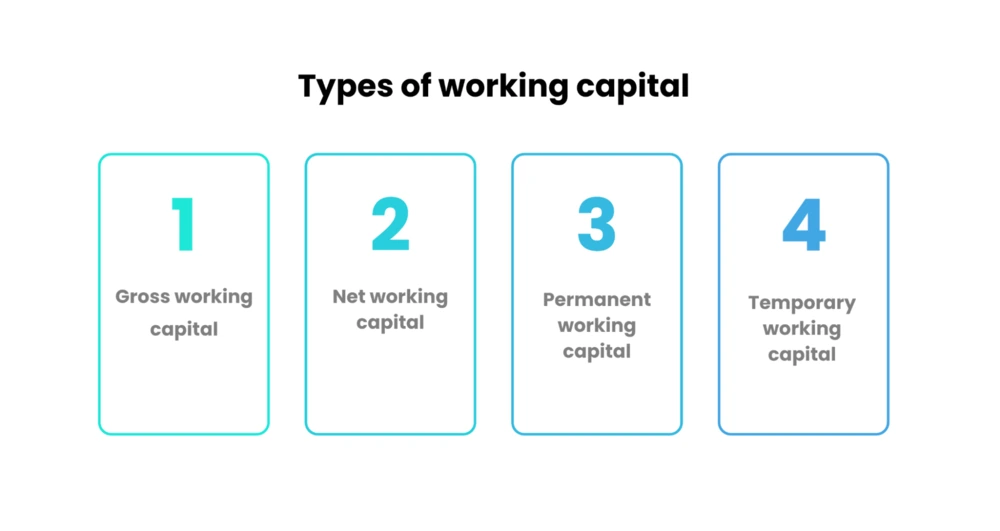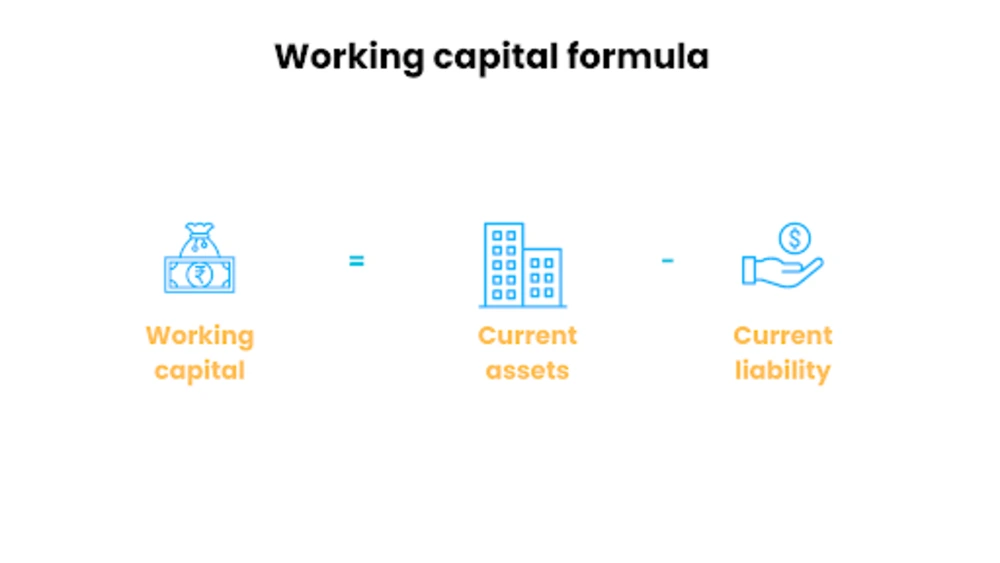Last Updated on November 28, 2025
What is working capital?
“Can’t a company just use its profits to cover its expenses?”
Well, technically, yes – but that’s not always the case. Sometimes a company’s profits are tied up in investments or other long-term assets, leaving them short on cash when it comes to immediate needs. That’s when you need working capital- the cash and other liquid assets can be used to cover these short-term expenses. It represents a company’s funds available to meet its short-term financial obligations, such as paying for raw materials, rent, and salaries.
Working capital is also sometimes known as operating capital, circulating capital, or current capital.
Suggested Read: The Ultimate Business Guide of Expense Management
Importance of working capital for businesses
Businesses need money to make money. If you are unable to afford your bills, buy inventory, or cover your employees’ salaries, you’re going to have a hard time generating revenue. That’s where working capital comes in – the financial cushion allows businesses to keep their operations running smoothly, even when cash flow is tight.
- Working or operating capital is essential for financing a business’s day-to-day operations and short-term needs.
- It allows businesses to cover expenses such as rent, salaries, and raw materials.
- Maintaining a healthy level of working capital helps businesses avoid cash flow shortages and financial difficulties.
- It enables businesses to take advantage of growth opportunities and make strategic investments.
- Current capital is an important metric for investors and lenders, as it indicates a business’s financial health and ability to meet its obligations.
- Having adequate current capital can improve a business’s creditworthiness and access to financing.
- On the other hand, inadequate operating capital can lead to missed payments, delayed shipments, and other operational challenges.
- By monitoring and managing their current capital, businesses can improve their efficiency, profitability, and overall success.
Quick Read: Cash Management System – Types, How It Works and Best Practices
Understanding the Importance of Working Capital
1. Cash flow management
- Current capital is crucial for managing cash flow, as it provides the funds needed to cover a business’s day-to-day expenses.
- By maintaining enough current capital, businesses can avoid cash flow shortages and ensure they have enough cash to meet their obligations.
- Managing current capital can help businesses improve their cash conversion cycle and reduce the time it takes to convert inventory into cash.
2. Operating cycle management
- The operating cycle is the time a business takes to convert raw materials into finished products, sell those products, and receive payment from customers.
- Operating capital is essential for managing the various stages of the operating cycle, including purchasing inventory, producing goods, and collecting payments.
- Businesses can shorten their operating cycle by optimizing their working capital and improving their efficiency, profitability, and cash flow.
3. Liquidity management
- Current capital is a key metric for liquidity management, as it indicates a business’s ability to meet its short-term obligations.
- Having adequate current capital is essential for maintaining liquidity and avoiding financial distress.
- By managing their current capital effectively, businesses can improve their liquidity position and reduce their risk of default or bankruptcy.
Quick Read: Cash Flow Statements: A Comprehensive Guide
Types of Working Capital
- Gross working capital
- Net working capital
- Permanent working capital
- Temporary working capital

1. Gross working capital
This refers to a company’s total current assets, including cash, accounts receivable, inventory, and other short-term assets. It represents the total amount of capital a company has available to fund its day-to-day operations.
2. Net working capital
Net working capital is the total difference between a company’s current assets (such as accounts receivable, inventory, and cash) and its current liabilities (such as accounts payable, short-term debt, and accrued expenses). It represents a company’s funds available to meet its short-term financial obligations.
3. Permanent working capital
This is the minimum amount of operating capital a company needs to maintain in order to fund its long-term operations. It includes the assets a company needs to hold onto, such as inventory and accounts receivable, to keep its business running smoothly.
4. Temporary working capital
This is the company’s extra current capital to fund its seasonal or cyclical operations. For example, a retailer might need extra operating capital during the holiday season to cover the costs of increased inventory and staffing. Temporary working capital is typically funded through short-term financings, such as lines of credit or short-term loans.
Quick Read: Cash Flow Forecasting: Definition, Advantages, and How to Ace It
Factors Affecting Working Capital
Here’s a brief explanation of the factors affecting capital and how they can impact a business.
- Nature of business
- Seasonal changes
- Credit policies
- Inventory management
- Accounts receivable management
- Accounts payable management
1. Nature of business
The type of business a company is in can have a significant impact on its current capital needs. For example, a manufacturing company may require more operating capital to fund its inventory and production costs than a service-based business. Understanding the unique operating capital requirements of a particular industry or business can help managers make informed decisions about how to allocate resources.
2. Seasonal changes
Businesses that experience seasonal fluctuations in demand may need extra operating capital to cover the costs of increased inventory, staffing, and marketing. For example, a retailer may need to build up inventory ahead of the holiday shopping season to meet customer demand. By planning for seasonal changes in advance and adjusting their current capital needs accordingly, businesses can avoid cash flow shortages and maintain profitability.
3. Credit policies
A company’s credit policies can impact its operating capital needs, particularly in relation to accounts receivable management. Offering generous credit terms to customers may increase sales, but it can also delay cash inflows and tie up capital in unpaid invoices. By implementing effective credit policies and managing accounts receivable effectively, businesses can strike a balance between sales growth and cash flow management.
4. Inventory management
Inventory is a key component of operating capital, and poor inventory management can tie up a significant amount of a company’s cash. Overstocking can lead to surplus inventory that takes up valuable warehouse space and restricts current capital, while understocking can lead to stockouts that result in lost sales. Effective inventory management involves finding the right balance between holding enough inventory to meet demand while minimizing excess stock.
5. Accounts receivable management
Managing accounts receivable is crucial for maintaining healthy current capital levels. Slow payment from customers can lock up operating capital in unpaid invoices, while prompt payment can help businesses maintain cash flow and meet their financial obligations. Effective accounts receivable management involves setting clear payment terms, monitoring customer payments, and following up on overdue invoices.
6. Accounts payable management
Managing accounts payable is also important for operating capital management. Delayed payment to suppliers can damage relationships and can cause late fees or interest charges, while prompt payment can improve cash flow and may lead to discounts or other benefits. Businesses can improve their operating capital by managing accounts payable effectively and negotiating favorable payment terms with suppliers.
Quick Read: Capital Expenditure (CapEX): Meaning, Types, Examples & Formula
Methods of managing working capital
Here are the methods of managing current capital:
- Cash management: This involves monitoring and managing a company’s cash inflows and outflows to ensure it has enough cash to meet its short-term financial obligations.
- Accounts receivable management: This involves managing a company’s accounts receivable to ensure that it is collecting payments from customers in a timely manner.
- Accounts payable management: This involves managing a company’s accounts payable to ensure that it is paying its bills on time while optimizing cash flow.
- Short-term borrowing: This involves using short-term financing, such as short-term loans or lines of credit, to cover current capital needs. Short-term borrowing can help businesses bridge cash flow gaps and cover unexpected expenses, but it should be managed carefully to avoid excessive debt.
- Long-term financing: This involves using long-term financing, such as term loans or equity financing, to fund long-term investments in the business.
By effectively managing these key components of operating capital, businesses can optimize their cash flow, minimize excess inventory and outstanding receivables, and maintain healthy relationships with suppliers and customers. This can ultimately lead to increased profitability and long-term financial stability.
Components of working or operating capital
- Current assets
- Current liabilities
- Inventory
- Accounts receivable
- Accounts payable
- Cash and cash equivalents

1. Current assets
Current assets are assets that you can simply convert to cash within a year or less. This includes cash, inventory, accounts receivable, and short-term investments. These assets are essential for day-to-day business operations and maintaining sufficient cash flow.
Quick Read: 10 Best Asset Management Software
2. Current liabilities
Current liabilities are debts due within a year or less. This includes accounts payable, short-term loans, and accrued expenses. These liabilities are necessary to pay for goods and services the business has already received or cover short-term cash flow needs.
3. Inventory
Inventory is the stock of goods or materials a business holds for sale or use in its operations. It includes raw materials, work-in-progress, and finished goods. Proper inventory management is crucial for maintaining sufficient stock levels while minimizing excess inventory.
4. Accounts receivable
Accounts receivable is the amount of money that a business owes its customers for its products or services sold on credit. Effective accounts receivable management is critical for collecting payments in a timely manner and improving cash flow.
5. Accounts payable
Accounts payable is the sum of money a company owes its suppliers for goods or services bought on credit. Managing accounts payable effectively is important for optimizing cash flow and maintaining good relationships with suppliers.
Quick Read: 10 Best Accounts Payable (AP) Software
6. Cash and cash equivalents
Cash and cash equivalents include cash on hand and short-term investments that can be easily converted into cash. Maintaining sufficient cash reserves is essential for meeting short-term financial obligations and covering unexpected expenses.
Concept of working capital
Working or current capital is the amount of money that a business has available to meet its short-term financial obligations. It is the difference between a company’s current assets and its current liabilities. Effective capital management is essential for businesses to maintain healthy cash flow, meet financial obligations, and invest in growth opportunities.
Detailed Explanation
Working capital is the lifeblood that keeps the business running smoothly, providing the necessary fuel to keep the engine going. In simple terms, it is the amount of money that a business has available to fund its daily operations, pay bills, and invest in growth opportunities.
Effective capital management is critical for businesses of all sizes. Without sufficient operating capital, businesses may struggle to pay their bills on time, meet payroll obligations, or take advantage of growth opportunities. Conversely, having too much capital tied up in inventory or accounts receivable can limit a business’s ability to invest in growth opportunities.
By understanding the concept of working (operating) capital and managing it effectively, businesses can optimize their cash flow, maintain healthy financials, and position themselves for long-term success.
Working capital formula
To calculate current capital, you subtract current liabilities from current assets. Current assets include cash, accounts receivable, inventory, and other assets that can be easily converted into cash within a year or less. Current liabilities include accounts payable, short-term loans, and other liabilities that are due within a year or less.
Working Capital = Current Assets – Current Liabilities

How to calculate working capital?
Here are the steps to calculate current capital:
- Determine your current assets:
Add up all your assets that can be converted into cash within a year or less. Examples of current assets include cash and cash equivalents, accounts receivable, inventory, and short-term investments.
- Determine your current liabilities:
Add up all your debts that are due within a year or less. Examples of current liabilities include accounts payable, short-term loans, and accrued expenses.
- Subtract current liabilities from current assets:
Subtract your current liabilities from your current assets. The resulting number is your operating capital.
For example, if a business has current assets of $100,000 and current liabilities of $50,000,
Working Capital = $100,000 – $50,000 = $50,000
So, the business has an operating capital of $50,000 available to fund its daily operations, pay bills, and invest in growth opportunities.
Working or operating capital example
- Retail store: A retail store has a positive operating capital when it has more current assets, such as inventory and accounts receivable, than current liabilities, such as accounts payable and short-term loans. This means the store has enough capital to cover its daily operations and invest in growth opportunities.
- Construction company: A construction company may have a negative current capital during the off-season when it has more current liabilities than current assets. However, during the busy season, the company may have positive operating capital due to increased revenue and decreased expenses.
- Startup company: A startup company may have negative capital during its early stages when it has high expenses and low revenue. As the company grows and generates more revenue, it may have a positive operating capital to fund its operations and expansion.
Quick Read: 6 Best Cash Flow Management Software
Advantages of working capital
Working or operating capital is a crucial part of a business’s financial health.
- Helps businesses to maintain smooth operations by covering their short-term expenses, such as paying bills and purchasing inventory.
- Improves cash flow management by ensuring a business has enough liquid assets to cover its short-term obligations.
- Enables businesses to invest in growth opportunities, such as expanding operations or launching new products.
- Enhances the credibility of the business by demonstrating its financial stability and ability to meet its financial obligations.
Limitations of working capital
- It does not account for long-term investments and financing decisions, which can significantly impact a business’s financial health.
- It is influenced by factors outside the control of the business, such as economic conditions and industry trends.
- It does not take into account the timing of cash inflows and outflows, which can impact a business’s ability to meet its short-term obligations.
- Accurately estimating operating capital needs can be difficult, especially for businesses with seasonal or cyclical sales patterns.
- It may not be a reliable indicator of a business’s overall financial health, as it only measures short-term liquidity. Other financial metrics, such as profitability and return on investment, may provide a more comprehensive picture of a business’s financial performance.
Quick Read: TOP 10 Financial Planning Tools
Best practices of working capital
To effectively manage capital, here are some best practices to follow:
- Keep a close eye on cash flow to ensure there is enough liquidity to cover short-term expenses.
- Keep inventory levels optimized to avoid excess inventory or stockouts.
- Manage accounts receivable and collections to improve cash flow.
- Negotiate favorable payment terms with suppliers to improve cash flow and reduce costs.
- Consider short-term financing options to cover any temporary gaps in current capital.
Positive vs negative working capital
Positive and negative working or current capital are two different financial positions of a company based on its current assets and liabilities. Positive current capital indicates that a company has enough current assets to cover its short-term obligations, while negative current capital suggests that a company may struggle to meet its short-term obligations.
Here’s a detailed table explaining the difference between positive and negative working capital:
|
|
Positive Working Capital |
Negative Working Capital |
|
Definition |
Positive working capital occurs when a company’s current assets are greater than its current liabilities. |
Negative working capital occurs when a company’s current liabilities are greater than its current assets. |
|
Financial Implication |
Positive current capital is generally considered a good sign because it suggests that a company is able to meet its short-term obligations and has liquidity to cover its day-to-day operations. |
Negative operating capital can be a cause for concern because it suggests that a company may have cash flow issues or may struggle to meet its short-term obligations using its current assets alone. |
|
Examples |
A company with $100,000 in current assets and $75,000 in current liabilities has positive operating capital of $25,000. |
A company with $50,000 in current assets and $75,000 in current liabilities has negative current capital of $25,000. |
|
Risks |
Although having positive working or operating capital is generally seen as positive, too much working or operating capital can also indicate that a company is not investing in growth or expansion opportunities. |
Negative current capital can indicate that a company is relying heavily on short-term financing, which can be risky if financing becomes more expensive or difficult to obtain. |
|
Industries |
Positive operating capital is typically more desirable for companies with long operating cycles, such as manufacturing companies, while negative operating capital may be acceptable for companies with short operating cycles, such as service businesses. |
Negative working capital is more common in industries where companies receive payment from customers after they have paid their own suppliers, such as retail or construction. |
Fixed capital vs working capital
Fixed capital and working or operating capital are two important components of a company’s capital structure. Fixed capital refers to the long-term funds invested in the business to purchase fixed assets such as property, plant, and equipment while working or operating capital refers to the short-term funds that are needed to run the day-to-day operations of a business.
Here’s a detailed table explaining the difference between fixed capital and working capital.
|
|
Fixed Capital |
Working Capital |
|
Definition |
Fixed capital refers to the long-term capital invested in a business for acquiring fixed assets, such as land, buildings, machinery, and equipment. |
Working or current capital refers to the short-term capital required to meet day-to-day operational expenses such as raw material, wages, and rent. |
|
Investment Purpose |
Fixed capital investments are used to purchase assets that are expected to provide long-term value to the business, such as land, buildings, and equipment. |
Working or operating capital investments are used to fund the daily operations of the business and to pay for expenses such as rent, wages, and inventory. |
|
Nature of Assets |
Fixed capital assets are typically long-term and have a useful life of more than one year. They are not easily convertible into cash. |
Current capital assets are typically short-term and have a useful life of less than one year. They are easily convertible into cash. |
|
Importance to the Business |
Fixed capital is critical to the success of the business in the long run as it provides the foundation for future growth and expansion. |
Working capital is essential for the day-to-day operations of the business, including paying suppliers, and employees, and managing inventory. Without sufficient working capital, a business may struggle to remain operational. |
|
Management |
Fixed capital investments are managed by the company’s finance department and are typically made after careful evaluation and analysis. |
Operating capital is managed by the company’s operations team, and it requires ongoing monitoring and control to ensure that it is being used effectively. |
|
Source of Funds |
Fixed capital is usually funded by long-term sources of finance such as equity, long-term loans, and debentures. |
Working capital is funded by short-term sources of finance such as trade credit, bank overdrafts, and short-term loans. |
Conclusion
In conclusion, working capital is a crucial aspect of any business’s financial management. It is essential to ensure that the company has sufficient liquidity to operate and grow without facing any cash flow issues. By implementing best practices for its management, businesses can achieve operational efficiency, and financial stability, and maximize profits.
FAQs
Net working or current capital refers to the difference between a company’s current assets and current liabilities. It measures the liquidity available to a business to meet its short-term obligations.
The formula for net working (NWC) capital is:
Current assets – Current liabilities = NWC.
Gross working or operating capital is the total amount of current assets a company has, including cash, accounts receivable, inventory, and other short-term assets.
The working capital turnover ratio is a financial ratio that measures how efficiently a company uses its current capital to generate revenue. It is calculated by dividing net sales by average operating capital.
The working capital cycle, also known as the cash conversion cycle, is the time it takes for a company to convert its current capital investment into cash flow. It includes the time it takes to sell inventory, collect accounts receivable, and pay accounts payable.
The working capital cycle is calculated by adding the number of days it takes to sell inventory to the number of days it takes to collect accounts receivable and subtracting the number of days it takes to pay accounts payable.
The length of the working capital cycle depends on the nature of the business, industry, and market conditions. Generally, the longer the cycle, the more working capital a business needs to operate.
Working capital requirements vary depending on the size of the business, the industry it operates in, and its growth plans. However, some common working capital requirements include inventory management, accounts receivable management, and cash flow management.
Working capital affects the balance sheet by impacting a company’s liquidity and solvency. A healthy working capital position can enhance a company’s creditworthiness and increase shareholder value, while a negative working capital position can indicate financial distress and instability.










Discussion about this post